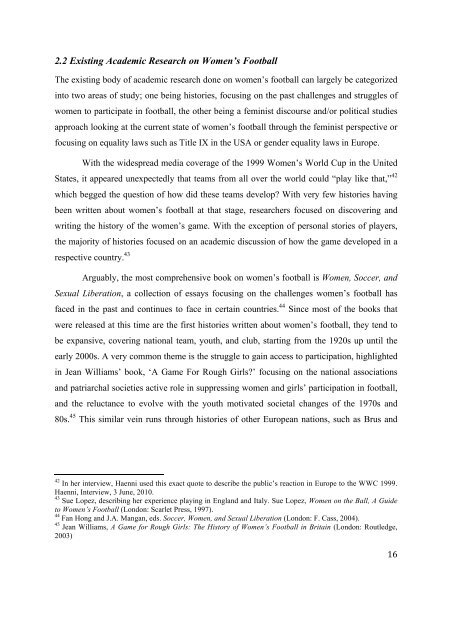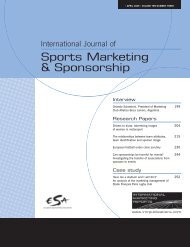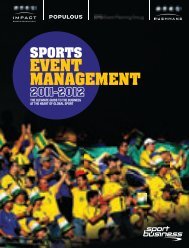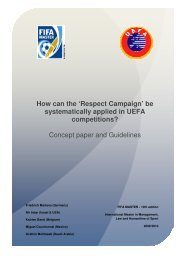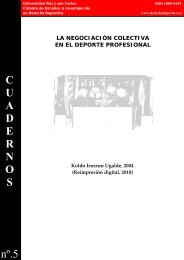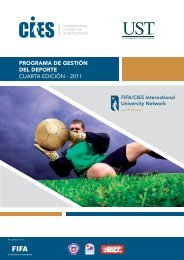women’s football development <strong>in</strong> the country, which will <strong>in</strong> turn improve the national team’sperformance. 382.1.5 European Women’s Club <strong>Football</strong>While media coverage <strong>in</strong> Europe grows for the national team competitions, UEFA becamepa<strong>in</strong>fully aware of the shortcom<strong>in</strong>gs of its European club competition, the UEFA Women’sCup. Those shortcom<strong>in</strong>gs were emphasized by the new found<strong>in</strong>g of the WPS <strong>in</strong> the USA,which promised to be “the best league <strong>in</strong> the world.” 39 Realiz<strong>in</strong>g its current <strong>in</strong>carnation of apan-European club competition was not sufficient, UEFA changed its format and re-brandedthe competition as the UEFA Women’s Champions League. This can be seen as a clearattempt to keep the most talented players <strong>in</strong> Europe by promis<strong>in</strong>g them a bigger stage for theclub game. In the strategic documents of the UEFA WCL the <strong>in</strong>fluence of the Americanleague on the re-brand<strong>in</strong>g becomes evident:“Follow<strong>in</strong>g the <strong>in</strong>troduction of the professional league <strong>in</strong> the USA, Europe isfac<strong>in</strong>g a ‘feet dra<strong>in</strong>’, with the migration of many of the best women’sfootballers to USA. Any consolidation of the UEFA Women’s ChampionsLeague must offer sufficient <strong>in</strong>centives to players to rema<strong>in</strong> <strong>in</strong> European clubs.The UEFA Women’s Champions League must be recognised as the mostattractive women’s club competition <strong>in</strong> the world.” 40The trans-Atlantic competition pushed UEFA towards tak<strong>in</strong>g action and strengthen<strong>in</strong>g itsEuropean club competition. The convergence of participation growth, <strong>in</strong>creased mediaattention for national team competitions, <strong>in</strong>stitutional back<strong>in</strong>g, which all <strong>in</strong>crease culturallegitimacy, has pushed to the forefront a very rapid development <strong>in</strong> European club women’sfootball, “as the next step for women’s football” 41""""""""""""""""""""""""""""""""""""""""""""""""""""""""38 Tessa Hayward, Women’s Leagues Coord<strong>in</strong>ator at The <strong>Football</strong> Association, <strong>in</strong>terviewed by Natalie Smith,<strong>in</strong>-person <strong>in</strong>terview, 12 May 2010, The English FA, Wembley Stadium, Wembley, England.39 ESPN Sun’s Nash <strong>in</strong>vests <strong>in</strong> new women’s league. February 2008. Available fromhttp://soccernet.espn.go.com/news/story?id=505170&cc=5739 [Accessed 15/06/2010]40 UEFA, Strategic Plan 2009/10 and 2010/11 Competition Strategy, Women’s Champions League, Nyon,2010.41 Hayward, Interview, 12, May 2010."!9"
2.2 Exist<strong>in</strong>g Academic Research on Women’s <strong>Football</strong>The exist<strong>in</strong>g body of academic research done on women’s football can largely be categorized<strong>in</strong>to two areas of study; one be<strong>in</strong>g histories, focus<strong>in</strong>g on the past challenges and struggles ofwomen to participate <strong>in</strong> football, the other be<strong>in</strong>g a fem<strong>in</strong>ist discourse and/or political studiesapproach look<strong>in</strong>g at the current state of women’s football through the fem<strong>in</strong>ist perspective orfocus<strong>in</strong>g on equality laws such as Title IX <strong>in</strong> the USA or gender equality laws <strong>in</strong> Europe.With the widespread media coverage of the 1999 Women’s World Cup <strong>in</strong> the UnitedStates, it appeared unexpectedly that teams from all over the world could “play like that,” 42which begged the question of how did these teams develop? With very few histories hav<strong>in</strong>gbeen written about women’s football at that stage, researchers focused on discover<strong>in</strong>g andwrit<strong>in</strong>g the history of the women’s game. With the exception of personal stories of players,the majority of histories focused on an academic discussion of how the game developed <strong>in</strong> arespective country. 43Arguably, the most comprehensive book on women’s football is Women, Soccer, andSexual Liberation, a collection of essays focus<strong>in</strong>g on the challenges women’s football hasfaced <strong>in</strong> the past and cont<strong>in</strong>ues to face <strong>in</strong> certa<strong>in</strong> countries. 44 S<strong>in</strong>ce most of the books thatwere released at this time are the first histories written about women’s football, they tend tobe expansive, cover<strong>in</strong>g national team, youth, and club, start<strong>in</strong>g from the 1920s up until theearly 2000s. A very common theme is the struggle to ga<strong>in</strong> access to participation, highlighted<strong>in</strong> Jean Williams’ book, ‘A Game For Rough Girls?’ focus<strong>in</strong>g on the national associationsand patriarchal societies active role <strong>in</strong> suppress<strong>in</strong>g women and girls’ participation <strong>in</strong> football,and the reluctance to evolve with the youth motivated societal changes of the 1970s and80s. 45 This similar ve<strong>in</strong> runs through histories of other European nations, such as Brus and""""""""""""""""""""""""""""""""""""""""""""""""""""""""42 In her <strong>in</strong>terview, Haenni used this exact quote to describe the public’s reaction <strong>in</strong> Europe to the WWC 1999.Haenni, Interview, 3 June, 2010.43 Sue Lopez, describ<strong>in</strong>g her experience play<strong>in</strong>g <strong>in</strong> England and Italy. Sue Lopez, Women on the Ball, A Guideto Women’s <strong>Football</strong> (London: Scarlet Press, 1997).44 Fan Hong and J.A. Mangan, eds. Soccer, Women, and Sexual Liberation (London: F. Cass, 2004).45 Jean Williams, A Game for Rough Girls: The History of Women’s <strong>Football</strong> <strong>in</strong> Brita<strong>in</strong> (London: Routledge,2003)"!:"
- Page 3: AcknowledgementsThe FIFA Master has
- Page 7 and 8: 4.5.4 Radio and Television Presence
- Page 9 and 10: !"#$%&'()*(+,%'-./0%1-,(1.1 “The
- Page 11 and 12: 1970 the General Assembly of the DF
- Page 13 and 14: 2.1.3 Increase in interest for nati
- Page 15: Similarly, UEFA has included gender
- Page 19 and 20: European context, with a strong emp
- Page 21: "“Røa players have between 1-yea
- Page 24 and 25: performs a sporting role as their m
- Page 26 and 27: Such occasions therefore help provi
- Page 28 and 29: implemented to create a distinct id
- Page 30 and 31: "• marketing and media• sponsor
- Page 32 and 33: Chapter 4: Data Analysis4.1 Adminis
- Page 34 and 35: skilled professional, such as websi
- Page 36 and 37: identified players with talent. 103
- Page 38 and 39: and women to participate in organiz
- Page 40 and 41: The club has to pay a rental fee on
- Page 42 and 43: full ownership by a larger club, wh
- Page 44 and 45: Only one or two clubs or federation
- Page 46 and 47: 4.5.5 Print Media PresenceAnother p
- Page 48 and 49: the sporting entity. This is why it
- Page 50 and 51: sponsorship categories to attract r
- Page 52 and 53: Table 3: Average Attendance - Speci
- Page 54 and 55: merchandise available through their
- Page 56 and 57: that the clubs continue this relati
- Page 58 and 59: growing healthy relationship betwee
- Page 60 and 61: 5.4 Growing costs for clubs, stayin
- Page 62 and 63: Without taking anything away from t
- Page 64 and 65: Chapter 6: RecommendationsThe follo
- Page 66 and 67:
values could be utilised by compani
- Page 68 and 69:
6.4 Knowledge and resource sharing:
- Page 70 and 71:
#economically self-sufficient, most
- Page 72 and 73:
!"#$"%&'()*+,#Advanced Learners Dic
- Page 74 and 75:
FFC Turbine Potsdam (2010) TurbineT
- Page 76 and 77:
Soccerway, Europe - UEFA Women's Ch
- Page 78 and 79:
!""#$%&'#(!""#$%&'()(*(+,+!(-&.(/01
- Page 80 and 81:
!""#$%&'()(*()+,+-,,(./0!(1234(56$7
- Page 82 and 83:
!"##!""#$%&'()*+(,(-./"0#(12#34&5$$


